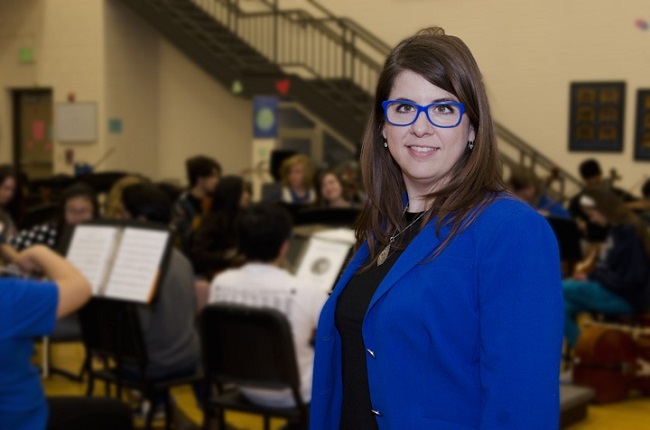
Peppy 35-year-old Michelle Hanlon plays the violin with the Dallas Bach Society and the Fain String Quartet. She substitutes in local symphony orchestras, and recently released her first vocal solo jazz CD. Workdays find her in Guyer High School’s orchestra hall managing and conducting the biggest regional string music teaching and performance program in the area.
Does life among that many teenagers produce a gray hair or two? Apparently the experience has had the opposite effect, because with flowing long brown hair she could pass for one of her own students. The royal blue frames of her studious, horn-rimmed style glasses stand out in any crowd.
“I grew up in Tyler where my father has a recording studio,” she said, “He produced four albums for ZZ Top.”
Inheriting Dad’s musical genes, she, like many Texas public school students, learned to play the violin in orchestra classrooms and halls. A high school choir member, she also participated in the marching band as a drum major. The lady is an eclectic musician.
“After high school I came to UNT and graduated in music education.” She student-taught in Denton public schools. You might guess, correctly, that her long suit is choral and instrumental music.
After several years as an assistant orchestra director, she took the podium in Guyer’s cavernous, state-of-the-art orchestra hall. That was 10 years ago. A bumper sticker size plaque on her office bulletin board says, “Get off my Bach?”
For the musically untutored, that whimsical exclamation point is an eighth note.
Nearly 180 students play in the four orchestras at the high school.
“Most of them have previous string experience before they register here,” she said, and weekly private lessons are a common practice.
The average fee for a half-hour private lesson is $20. Students own instruments or rent them from music companies or the school district.
At Denton ISD, group string music instruction is available beginning in the 5th grade. The University of North Texas offers a string project for children as young as second grade. A cadre of UNT music students work beside faculty professionals as private lesson teachers.
“To succeed at anything, children of all ages need positive parental encouragement,” Ms. Hanlon said. “Moms and Dads model how to stick out challenges or quit. Practice is not a punishment, but part of a long-term endeavor that will reap wonderful rewards.”
Guyer’s string players are assigned by ability and experience to the non-competitive Philharmonic Orchestra for freshmen and sophomore beginners; the competitive Cadenza Orchestra for more experienced upper classmen; or either audition-only ensembles called the Intermezzo and Rhapsody Orchestras.
“We take the Intermezzo and Rhapsody players to the University Interscholastic League (UIL) contest every year, and they have a tradition of winning Sweepstakes.”
Many years the Cadenza players compete and place among the audition-only orchestras. That says a lot about the program’s high quality.
“Taking Sweepstakes means in every music contest event the panel of judges gives the competing orchestra a score of ones straight across the board.”
Not to brag, of course, but “We’ve produced four All State violinists, and student Inki Lee has received that honor twice.”
Four instruments make up the string section of a performance group: violin, viola, cello and double bass. The string players sit in a sunburst horse shoe around the conductor.
In a complete symphony orchestra, the band sections rise on graduated platforms behind the strings. There is a method to the seating arrangement. The objective is to enable the conductor and audience to hear all of the instruments. String instruments have a greater dynamic range or capacity to play loud and soft than brass instruments. You might have noticed trumpet blasts always come from up in the back row.
The concertmaster sits in the front row directly to the left of the conductor. All of the performers tune to match his/her instrument. A typical string orchestra is seated by instrumental voice left to right in the horse shoe. The two high-voiced violin sections sit left most; one section of violas, bigger instruments with lower voices, fills the center. Then on the conductor’s right are the cellos and behind them the double basses, the lowest voices of all.
Orchestra differs quite a bit from band.
“String players don’t have to devote learning time to marching routines, so we can focus on the literature and music year round.”
At Guyer, the three music programs join forces twice a year to perform symphonic pieces.
“Our spring concert features a full symphony (orchestra and band combined), the choir, with solos by our All State students.”
Don’t consign string players to the long-hair division of musical taste.
“We perform pops concerts.” Like Star Wars? “We learn familiar movie music and, at Christmas, we get everyone in the holiday spirit with a great rendition of Sleigh Ride complete with whip cracking, jingle bells and horses neighing!”
Students of reasonable ability, without Tiger Moms, can succeed as string instrument players.
“Nothing can replace diligent practice which develops finger dexterity, neural pathway development, memory, literacy and artistic thought.”
Everyone isn’t a born virtuoso, but that doesn’t mean lives can’t be enriched by rubbing intellectual shoulders with the likes of Bach, Mozart or Tchaikovsky.
This will date you, but remember that old Puffed Wheat television commercial where a lab-coated geek shot off cannons of cereal while the orchestra played the 1812 Overture? Daffy Duck hilariously stomped his big feet up and down backstage theater steps in perfect time with a Hungarian Rhapsody. Can-can high steppers strutted their ruffles to Orpheus In The Underworld, and the Lone Ranger and Tonto galloped to the rescue accompanied by the William Tell Overture.
High school string orchestras have a performance uniform called formal evening wear. The girls wear flattering, floor length, identical black gowns and boys wear black tuxedos provided by the district. From time to time soloists may sport a little glitz, but the object of somber clothing is to let the audience and/or contest judges focus on the music rather than be distracted by a high fashion parade.
Musical learning is part of a well rounded life for most students who don’t go on to become professional performers.
“We hear from students years later,” Ms. Hanlon said, “and they all say the musical experience was terrific, but orchestra was more than that. They made friends who stayed with them over the years. Orchestra hall was a home away from home. It was a place where they learned to help each other succeed.”
What parent doesn’t want their child to get all that out of school?
Contact Noelle Hood at [email protected]



















